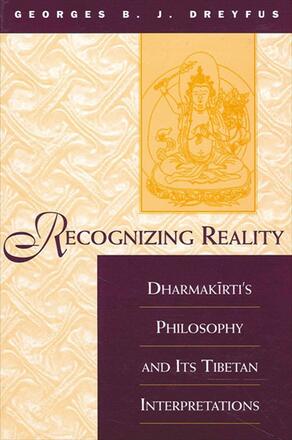Preface and Acknowledgments
Technical Notes
Introduction I.
A Few Methodological Considerations Purpose and Content
The Commentarial Style of Indian and Tibetan Philosophical Traditions
Scholarly Context
The Hermeneutical Significance of Comparison
The Structure of the Work
Introduction II.
Dharmakirti's Tradition in India and Tibet
The Epistemological Turn in Indian Philosophy
The Place of Dharmakirti in Indian Buddhism
Dharmakirti's Tradition in Tibet
Foundation of the Sa-gya Scholastic Tradition
A Conflict of Interpretations
Sa-gya Commentators
The Rise of the Ge-luk Tradition
The Origin and Significance of Sectarian Divisions
Book One. Ontology and Philosophy of Language
Part I. Ontology
Chapter 1
Ontology and Categories
Indian Philosophy and the Pramana Method
Epistemology and Ontological Commitments
Indian Schools of Philosophy
Nyaya Realism and the Importance of Categories
The Meanings of Realism
Nyaya Realism and the Status of Wholes
Dharmakiti's Critique of Substance
Chapter 2
Dharmakirti's Ontology
Momentariness and the Structure of Dharmakirti's System
Dharmakirti on Momentariness
Causal Nature of Reality
Dharmakirti's Ontology and Its Relation to the Problem of Universals
Uncommoness and Identity Conditions
Chapter 3
The Ambiguities of the Concept of Existence
The Problems of Dharmakirti's Concepts of Existence
Sa-pan's Controversial Views on Existence
Defenses and Interpretations of Sa-pan
Chapter 4
The Purview of the "Real"
Atomic Theory An Alternate Interpretation
No Extended Object Can Be Real
Some Extended Objects Are Real
Extension in Space and Time
All Extended Objects Are Real
Who Is Right?
Yogacara in Dharmakirti's System
Is Dharmakirti Contradicting Himself?
Chapter 5
Ge-luk Thinkers on Specific Ontology
Commonsense Objects and Universals
Ge-luk Realism and Commonsense Objects
Realism and Momentariness
Philosophy and the Validity of Conventions
Realist Explanations of the Nature of the Specifically Characterized
Nominal Existence and Existence
A Partial Reconciliation
Conclusion
Part II.
The Problem Of Universals
Chapter 6
Introducing Universals
Three Dimensions in the Problem of Universals
Antirealism and Its Varieties: Conceptualism and Nominalism
Extreme and Moderate Realisms and Their Predicaments
Realism in India
Moderate Realism in Indian Traditions
Why Bother with Universals?
Chapter 7
Dharmakirti on Universals
Logic and Ontology
Dharmakirti's Arguments Against Realism
The Roles of Universals
Universals and Similarities
An Assessment of Resemblance Theory
Chapter 8
Sa-gya Antirealism and the Problems of Predication
Sa-pan's Refutation of Realism
Sakya Chok-den on Predication
Predication and the Validity of Thought
Are Distinguishers Parts of Reality?
The Conceptual Nature of Individuations
Chapter 9
Ge-luk Realism
Universals in the Collected Topics
One and Many
Arguments for Moderate Realism
Subject and Predicate
Philosophy and Linguistic Ambiguities
Chapter 10
Realism in Buddhist Tradition
Two Early Tibetan Realists
Moderate Realism in Tibet and Madhyamaka
Moderate Realism in India
The Role of Universals in Inference
Conclusion
Part III.
Philosophy Of Language
Chapter 11
Introduction to Apoha
The History of Apoha and its Reception Grammar and Philosophy of Language in India
Dignaga on Apoha
Hindu Reactions: the Mimamsa View
Chapter 12
Dharmakirti on Concept Formation
Thought and Language
Two Definitions of Thought
The Negative Nature of Conceptuality
Formation of Concept
The Mistaken Nature of Concepts
Conclusion: Dharmakirti's Response to the Hindu Critique
Chapter 13
The Concept of Negation and the Evolution of the Apoha Theory
Are Negation and Elimination Equivalent?
Objective Elimination
Santaraksita on Representations
The Evolution of the Apoha Theory
Ge-luk Views of Negations
Sa-gya Views on Negations
Chapter 14
Object Universal and Concept Formation
Importance of the Notion of Object
Universal in the Tibetan Tradition
Object Universal in the Ge-luk Tradition
Object Universal in the Sa-gya Tradition
Comparative Conclusion
Chapter 15
Philosophy of Language
The Terminology of the Inquiry
Ineffability
Dharmakirti on Name and Reference
Signifier and Signified
A Sa-gya View
Moderate Realism and Language
Book Two. Epistemology
Part I. Valid Cognition
Chapter 16
Dharmakirti's Epistemology of Valid Cognition
Mental Terminology and the Mind-Body Problem
Knowledge and Pramana
Defining Pramana
The Epistemological Role of Language
Epistemological Typology
Chapter 17
Was Dharmakirti a Pragmatist?
Valid Cognition and Its Object
An Intentional Interpretation
The Requirement of Novelty
A Pragmatist Explanation of Nondeceptiveness
A Pragmatic Theory of Truth?
Reductionism and Intentionality
Chapter 18
Can Inference Be Valid?
Dharmakirti on the Validity of Thought
A Major Difficulty in Dharmakirti's System
A Realist Answer
Conclusion
Part II.
Perception
Chapter 19
Philosophy of Perception
Representationalism and Its Problems
Representationalism and Realism in Indian Philosophy
Aspects and Reflexivity
The Foundational Significance of Aspects
Chapter 20
Dharmakirti's Account of Perception
The Nyaya Theory of Perception
Dharmakirti's Definition of Perception
Dharmakirti's Arguments
Chapter 21
A New Epistemology Begins: Dharmottara on Perception
Dharmottara as a Commentator and an Innovator
The Validity of Perception
Bridging the Gap Between Perception and Conception
Does Perception Determine Its Object?
Chapter 22
Tibetan New Epistemology
Cha-ba's Epistemology of Perception
Ge-luk Views of Perception
Implicit and Explicit
Epistemological Typologies
Chapter 23
Cha-ba's Philosophy of Mind
Cha-ba's Typology of Objects
Sakya Chok-den's Polemical Use of History
Critical Appraisal
Chapter 24
Sa-pan's Critique of the New Epistemology
Sa-pan's Rejection of Cha-ba's Typology
The Case of Inattentive Cognition
Ascertainment Is Conceptual
Explicit and Implicit
Dharmakirti's Problem and Sa-pan's Solution
Chapter 25
Perception and Apperception
Dharmakirti on the Self
Presencing of Mental States
Does Self-Cognition Have an Object?
Go-ram-ba's Representationalism
A Ge-luk Understanding of Dharmakirti's Aspects
Representationalism, Realism, and Causal Theories
The Soteriological Implications of Apperception
Chapter 26
Are External Objects Perceptible?
Are Objects Hidden or Hidden"?
An Unstable Compromise: Go-ram-ba's Representationalism
The Difficulties of Representationalism
External Objects Inferred?
How Hidden Can "Hidden" Be?
Chapter 27
Epistemology, Metaphysics, and Religion
Yogacara in Dharmakirti's Thought
True or False Aspect?
Sakya Chok-den on Yogacara
The Importance of Yogacara in Dharmakirti's Thought
Philosophy and Soteriology in Dharmakirti
Conclusion
Conclusion: Philosophy as an Education of the Mind
Realism and Antirealism as Interpretations
Philosophy as an Education
Epistemology and the Madhyamaka Critique
Prasangika and Epistemology: Dzong-ka-ba's Realism
Go-ram-ba's Suspicion of Language
Buddhist Epistemology as an Education
Notes
Glossary: Tibetan - Sanskrit - English
Glossary: Sanskrit - Tibetan - English
Bibliography
Author Index
Subject Index
